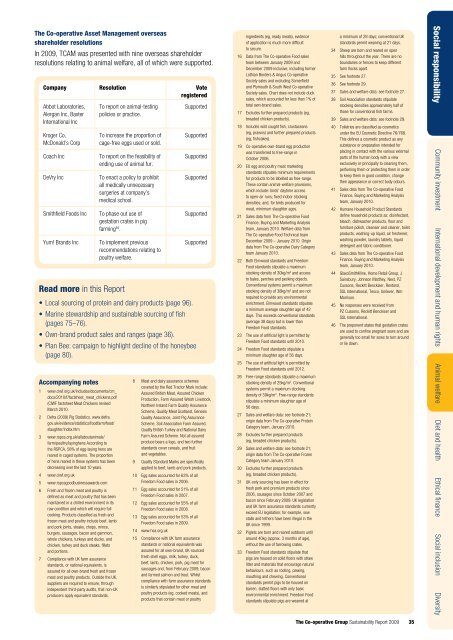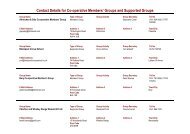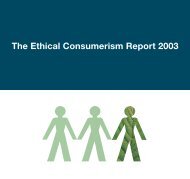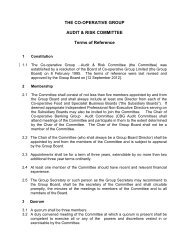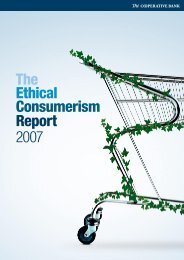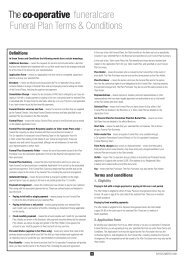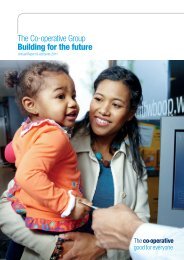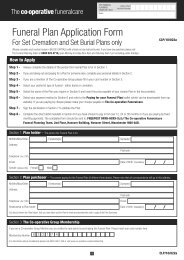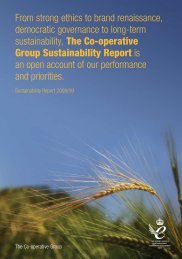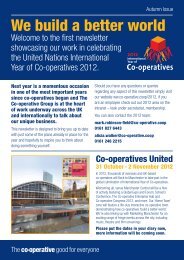Sustainability Report 2009 - The Co-operative
Sustainability Report 2009 - The Co-operative
Sustainability Report 2009 - The Co-operative
You also want an ePaper? Increase the reach of your titles
YUMPU automatically turns print PDFs into web optimized ePapers that Google loves.
<strong>The</strong> <strong>Co</strong>-<strong>operative</strong> Asset Management overseas<br />
shareholder resolutions<br />
In <strong>2009</strong>, TCAM was presented with nine overseas shareholder<br />
resolutions relating to animal welfare, all of which were supported.<br />
<strong>Co</strong>mpany Resolution Vote<br />
registered<br />
Abbot Laboratories,<br />
Alergan Inc, Baxter<br />
International Inc<br />
Kroger <strong>Co</strong>,<br />
McDonald’s <strong>Co</strong>rp<br />
<strong>Co</strong>ach Inc<br />
DeVry Inc<br />
Smithfield Foods Inc<br />
Yum! Brands Inc<br />
Read more in this <strong>Report</strong><br />
• Local sourcing of protein and dairy products (page 96).<br />
• Marine stewardship and sustainable sourcing of fish<br />
(pages 75–76).<br />
• Own-brand product sales and ranges (page 36).<br />
• Plan Bee: campaign to highlight decline of the honeybee<br />
(page 80).<br />
Accompanying notes<br />
1 www.ciwf.org.uk/includes/documents/cm_<br />
docs/2010/f/factsheet_meat_chickens.pdf<br />
(CIWF factsheet Meat Chickens revised<br />
March 2010.<br />
2 Defra (<strong>2009</strong>) Pig Statistics. www.defra.<br />
gov.uk/evidence/statistics/foodfarm/food/<br />
slaughter/index.htm<br />
3 www.rspca.org.uk/allaboutanimals/<br />
farm/poultry/layinghens According to<br />
the RSPCA, 58% of egg-laying hens are<br />
reared in caged systems. <strong>The</strong> proportion<br />
of hens reared in these systems has been<br />
decreasing over the last 10 years.<br />
4 www.ciwf.org.uk<br />
5 www.rspcagoodbusinessawards.com<br />
6 Fresh and frozen meat and poultry is<br />
defined as meat and poultry that has been<br />
maintained in a chilled environment in its<br />
raw condition and which will require full<br />
cooking. Products classified as fresh and<br />
frozen meat and poultry include beef, lamb<br />
and pork joints, steaks, chops, mince,<br />
burgers, sausages, bacon and gammon,<br />
whole chickens, turkeys and ducks, and<br />
chicken, turkey and duck steaks, fillets<br />
and portions.<br />
7 <strong>Co</strong>mpliance with UK farm assurance<br />
standards, or national equivalents, is<br />
assured for all own-brand fresh and frozen<br />
meat and poultry products. Outside the UK,<br />
suppliers are required to ensure, through<br />
independent third-party audits, that non-UK<br />
producers apply equivalent standards.<br />
To report on animal-testing<br />
policies or practice.<br />
To increase the proportion of<br />
cage-free eggs used or sold.<br />
To report on the feasibility of<br />
ending use of animal fur.<br />
To enact a policy to prohibit<br />
all medically unnecessary<br />
surgeries at company’s<br />
medical school.<br />
To phase out use of<br />
gestation crates in pig<br />
farming 46 .<br />
To implement previous<br />
recommendations relating to<br />
poultry welfare.<br />
Supported<br />
Supported<br />
Supported<br />
Supported<br />
Supported<br />
Supported<br />
8 Meat and dairy assurance schemes<br />
covered by the Red Tractor Mark include:<br />
Assured British Meat, Assured Chicken<br />
Production, Farm Assured Welsh Livestock,<br />
Northern Ireland Farm Quality Assurance<br />
Scheme, Quality Meat Scotland, Genesis<br />
Quality Assurance, Joint Pig Assurance<br />
Scheme, Soil Association Farm Assured,<br />
Quality British Turkey and National Dairy<br />
Farm Assured Scheme. Not all assured<br />
produce bears a logo, and two further<br />
standards cover cereals, and fruit<br />
and vegetables.<br />
9 Quality Standard Marks are specifically<br />
applied to beef, lamb and pork products.<br />
10 Egg sales accounted for 63% of all<br />
Freedom Food sales in 2006.<br />
11 Egg sales accounted for 51% of all<br />
Freedom Food sales in 2007.<br />
12 Egg sales accounted for 55% of all<br />
Freedom Food sales in 2008.<br />
13 Egg sales accounted for 53% of all<br />
Freedom Food sales in <strong>2009</strong>.<br />
14 www.hsa.org.uk<br />
15 <strong>Co</strong>mpliance with UK farm assurance<br />
standards or national equivalents was<br />
assured for all own-brand, UK-sourced<br />
fresh shell eggs, milk, turkey, duck,<br />
beef, lamb, chicken, pork, pig meat for<br />
sausages and, from February <strong>2009</strong>, bacon<br />
and farmed salmon and trout. Whilst<br />
compliance with farm assurance standards<br />
is similarly stipulated for other meat and<br />
poultry products (eg, cooked meats), and<br />
products that contain meat or poultry<br />
ingredients (eg, ready meals), evidence<br />
of application is much more difficult<br />
to secure.<br />
16 Data from <strong>The</strong> <strong>Co</strong>-<strong>operative</strong> Food sales<br />
team between January <strong>2009</strong> and<br />
December <strong>2009</strong> inclusive, including former<br />
Lothian Borders & Angus <strong>Co</strong>-<strong>operative</strong><br />
Society sales and excluding Somerfield<br />
and Plymouth & South West <strong>Co</strong>-<strong>operative</strong><br />
Society sales. Chart does not include duck<br />
sales, which accounted for less than 1% of<br />
total own-brand sales.<br />
17 Excludes further prepared products (eg,<br />
breaded chicken products).<br />
18 Includes wild caught fish, crustaceans<br />
(eg, prawns) and further prepared products<br />
(eg, fishcakes).<br />
19 <strong>Co</strong>-<strong>operative</strong> own-brand egg production<br />
was transferred to free-range in<br />
October 2006.<br />
20 EU egg and poultry meat marketing<br />
standards stipulate minimum requirements<br />
for products to be labelled as free-range.<br />
<strong>The</strong>se contain animal-welfare provisions,<br />
which include: birds’ daytime access<br />
to open-air runs; fixed indoor stocking<br />
densities; and, for birds produced for<br />
meat, minimum slaughter ages.<br />
21 Sales data from <strong>The</strong> <strong>Co</strong>-<strong>operative</strong> Food<br />
Finance, Buying and Marketing Analysis<br />
team, January 2010. Welfare data from<br />
<strong>The</strong> <strong>Co</strong>-<strong>operative</strong> Food Technical team<br />
December <strong>2009</strong> – January 2010. Origin<br />
data from <strong>The</strong> <strong>Co</strong>-<strong>operative</strong> Dairy Category<br />
team January 2010.<br />
22 Both Elmwood standards and Freedom<br />
Food standards stipulate a maximum<br />
stocking density of 30kg/m 2 and access<br />
to bales, perches and pecking objects.<br />
<strong>Co</strong>nventional systems permit a maximum<br />
stocking density of 38kg/m 2 and are not<br />
required to provide any environmental<br />
enrichment. Elmwood standards stipulate<br />
a minimum average slaughter age of 42<br />
days. This exceeds conventional standards<br />
(average 38 days) but is lower than<br />
Freedom Food standards.<br />
23 <strong>The</strong> use of artificial light is permitted by<br />
Freedom Food standards until 2010.<br />
24 Freedom Food standards stipulate a<br />
minimum slaughter age of 56 days.<br />
25 <strong>The</strong> use of artificial light is permitted by<br />
Freedom Food standards until 2012.<br />
26 Free-range standards stipulate a maximum<br />
stocking density of 25kg/m 2 . <strong>Co</strong>nventional<br />
systems permit a maximum stocking<br />
density of 59kg/m 2 . Free-range standards<br />
stipulate a minimum slaughter age of<br />
56 days.<br />
27 Sales and welfare data: see footnote 21;<br />
origin data from <strong>The</strong> <strong>Co</strong>-<strong>operative</strong> Protein<br />
Category team, January 2010.<br />
28 Excludes further prepared products<br />
(eg, breaded chicken products).<br />
29 Sales and welfare data: see footnote 21;<br />
origin data from <strong>The</strong> <strong>Co</strong>-<strong>operative</strong> Frozen<br />
Category team January 2010.<br />
30 Excludes further prepared products<br />
(eg, breaded chicken products).<br />
31 UK-only sourcing has been in effect for<br />
fresh pork and premium products since<br />
2006, sausages since October 2007 and<br />
bacon since February <strong>2009</strong>. UK legislation<br />
and UK farm assurance standards currently<br />
exceed EU legislation; for example, sow<br />
stalls and tethers have been illegal in the<br />
UK since 1999.<br />
32 Piglets are born and reared outdoors until<br />
around 40kg (approx. 3 months of age),<br />
without the use of farrowing crates.<br />
33 Freedom Food standards stipulate that<br />
pigs are housed on solid floors with straw<br />
litter and materials that encourage natural<br />
behaviours, such as rooting, pawing,<br />
mouthing and chewing. <strong>Co</strong>nventional<br />
standards permit pigs to be housed on<br />
barren, slatted floors with only basic<br />
environmental enrichment. Freedom Food<br />
standards stipulate pigs are weaned at<br />
a minimum of 28 days; conventional UK<br />
standards permit weaning at 21 days.<br />
34 Sheep are born and reared on open<br />
hills throughout the year. <strong>The</strong>re are no<br />
boundaries or fences to keep different<br />
farm flocks apart.<br />
35 See footnote 27.<br />
36 See footnote 29.<br />
37 Sales and welfare data: see footnote 27.<br />
38 Soil Association standards stipulate<br />
stocking densities approximately half of<br />
those for conventional fish farms.<br />
39 Sales and welfare data: see footnote 29.<br />
40 Toiletries are classified as cosmetics<br />
under the EU <strong>Co</strong>smetic Directive 76/768.<br />
This defines a cosmetic product as any<br />
substance or preparation intended for<br />
placing in contact with the various external<br />
parts of the human body with a view<br />
exclusively or principally to cleaning them,<br />
perfuming them or protecting them in order<br />
to keep them in good condition, change<br />
their appearance or correct body odours.<br />
41 Sales data from <strong>The</strong> <strong>Co</strong>-<strong>operative</strong> Food<br />
Finance, Buying and Marketing Analysis<br />
team, January 2010.<br />
42 Humane Household Product Standards<br />
define household products as: disinfectant,<br />
bleach, dishwasher products, floor and<br />
furniture polish, cleanser and cleaner, toilet<br />
products, washing-up liquid, air freshener,<br />
washing powder, laundry tablets, liquid<br />
detergent and fabric conditioner.<br />
43 Sales data from <strong>The</strong> <strong>Co</strong>-<strong>operative</strong> Food<br />
Finance, Buying and Marketing Analysis<br />
team, January 2010.<br />
44 GlaxoSmithKline, Home Retail Group, J<br />
Sainsbury, Johnson Matthey, Next, PZ<br />
Cussons, Reckitt Benckiser, Rentorol,<br />
SSL International, Tesco, Unilever, Wm<br />
Morrison.<br />
45 No responses were received from<br />
PZ Cussons, Reckitt Benckiser and<br />
SSL International.<br />
46 <strong>The</strong> proponent states that gestation crates<br />
are used to confine pregnant sows and are<br />
generally too small for sows to turn around<br />
or lie down.<br />
Social responsibility <strong>Co</strong>mmunity investment International development and human rights Animal welfare Diet and health Ethical finance Social inclusion Diversity<br />
<strong>The</strong> <strong>Co</strong>-<strong>operative</strong> Group <strong>Sustainability</strong> <strong>Report</strong> <strong>2009</strong> 35


